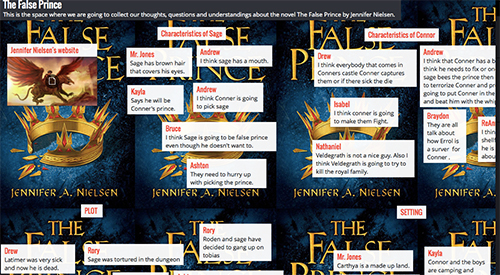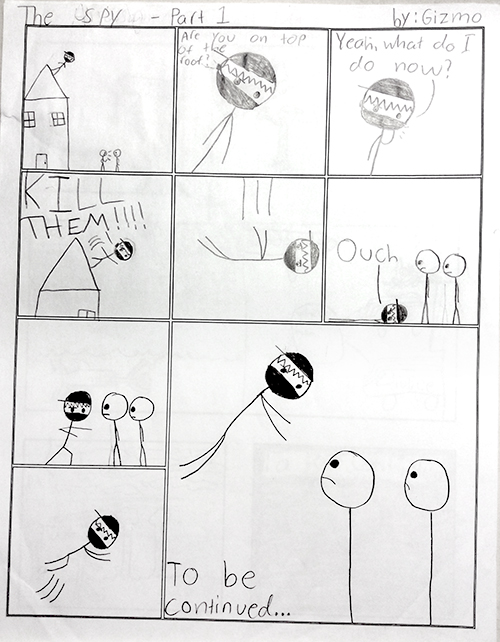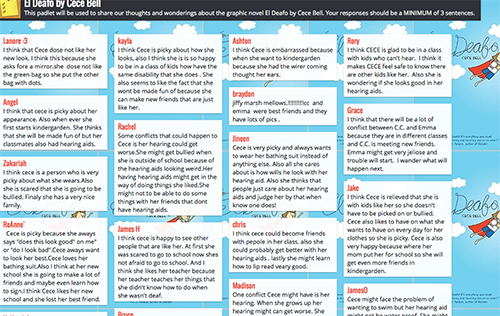Chapter 7: Cultivating Student Ownership with Audience, Autonomy, Discourse and Reflection
7.4 Essential #3: Collaborative Conversations

Conversations occur in all classrooms in some form or another. Some teachers use conversation as a method for collaborative problem-solving. Some teachers use conversation to allow students to share opinions and new understandings about a topic or text. A number of digital tools have made it possible to ensure that discourse among students is purposeful and open. Gone are the days where students that want to contribute have to sit on the periphery of discussions. Making digital discourse part of the classroom culture has given power to my students’ voices as a way to:
- Grapple with the literal and inferential meaning of texts
- Clarify their understandings about content
- Encourage students to talk with one another about their learning
- Develop critical thinking skills
Year after year, read aloud tends to be the time of day when the most conversations take place. It also happens to be my students’ favorite time of day. Quite frankly, it is mine as well. I love sitting with my students and reading a great book. As a result of integrating a few digital tools into our class read aloud routine, the discussions that takes place are collaborative, rich, dynamic and focused.
 Graphic novels are useful in scaffolding comprehension and building a reader’s inference skills. That is why I find it important to explicitly teach students how to use a graphic novel’s unique features to understand and critically think about the text. Here are some of the basic visual text features a graphic novel that I believe readers must discern:
Graphic novels are useful in scaffolding comprehension and building a reader’s inference skills. That is why I find it important to explicitly teach students how to use a graphic novel’s unique features to understand and critically think about the text. Here are some of the basic visual text features a graphic novel that I believe readers must discern:
• Panels
◦ Squares or rectangles that contain a single scene
◦ Panels give structure to the narrative
◦ Breaks apart the page into a series of visual moments
◦ The size of the panel may indicate the importance of a character or event to the plot. Pages with fewer panels mean pages that read quickly and emphasizes big, climatic moments. A page with a greater amount of smaller panels page capture a lot of small moments.
• Gutters
◦ The space between panels
◦ Natural breaks for reader to pause and reflect on comprehension
◦ Readers must predict and infer what is happening between panels
◦ Readers find meaning in the transitions from scene to scene
◦ Indicate a passage of time, change of setting, or change of point of view
• Dialog Balloons
◦ Contain communication between/among characters
◦ Use to indicate which part of the action needs dialogue and which parts do not
• Thought Balloons
◦ Contain a character’s thoughts and ideas
◦ Shows the internal story of a character
• Captions
◦ Information from the author
◦ Filling in holes of what the reader may need to know
◦ Contain information about a scene, character or description
◦ Tells us about the setting
◦ explains character’s journey
• Sound Effects
◦ Visual sound clues
◦ Reassures the reader that we do not live in a silent world
◦ Stimulates the reader’s senses
Projecting The Text
This year, I read the 2015 Newbery Honor award-winner El Deafo by Cece Bell to my class. It was one of my most successful read alouds ever. What made it success was the discourse that resulted from a simple adjustment. Since it is a graphic novel, I downloaded the Kindle version and projected it onto the Smartboard. In doing so, my students were visually captivated by Cece Bell’s wonderful illustrations. It allowed us to talk about how to truly read a graphic novel, and use the different elements of a graphic novel to make meaning. We discussed panels, gutters, dialogue bubbles, and thought bubbles. My students grew accustomed to having the text projected as I read, and as a result, my students insisted that I project the text for our next read aloud. What I love about this idea is that now I can model fluent and expressive reading while students see the same text I’m seeing. This opened up a variety of discussion points such as: how punctuation affected my voice or how authors use text features to create meaning. Not only that, but I used the highlighting tool in the Kindle app to make any words or sentences that made an impact on me or made me ask a question as I read. I also highlighted examples from the text that corresponded with teaching points from writing workshops (e.g. using vivid verbs, character’s thinking and responses to actions, blending action, dialogue and thinking). By being able to share the text (without wasting paper and time making multiple paper copies), our conversation around this book was more productive. Furthermore, the text was accessible to all readers regardless of their reading level. Each student was able to enjoy and share in the conversation around the book.
Digital Bulletin Boards
During our daily interactive novel read aloud, my students and I would stop and talk so much about characters, plot, themes and author’s style, that we ran out of time too quickly. So, I experimented with using digital bulletin boards (e.g. Padlet) as a way to continue the conversation beyond the classroom walls. Before the day’s reading started, I asked five students to get an iPad so they could add to our Read Aloud Wall. While I read, these students recorded their thoughts or typed important details or “a-ha moments” from the book. After we finished reading that day’s chapters, or before we read the following day, the class and I visited our digital bulletin board and discussed what the students had written. On occasion, students added their thoughts to our board at home. This didn’t replace our interactive discussions while reading; yet, it did enhance them. It gave students who might not contribute during a discussion an audience to share their thoughts.
Having read the responses beforehand, occasionally I would pick one or two responses that I thought might evoke deeper thinking and ask students to comment on them. Or I might ask students to choose a response on which they would like to comment. This focus got us started thinking about what we had previously read and alleviated the potential for getting off topic. The in-class dialogue between students about these boards also allowed students to give each other feedback and ask clarifying questions, thus clearing up any misunderstandings about the text. Here are some examples of digital bulletin boards:
 After reading the first few chapters of El Deafo, students and I discussed our first impressions of the book. We discussed questions such as: How is the author introducing the character to readers? What strategies is the author using to establish the situation (i.e. setting the scene) for the reader? What are some conflicts that you predict might happen to the main character? I asked students to keep pondering what we discussed and let it sink in for a while. I went on to ask students to post their thoughts and new understandings about this book onto our El Deafo bulletin board sometime before read aloud the next day. Many students opted to do this at home. Others asked to post during the afternoon because they did not have Internet access at home, which I gladly accommodated. The following day, I projected our digital bulletin board and asked students to comment on another student’s thoughts.
After reading the first few chapters of El Deafo, students and I discussed our first impressions of the book. We discussed questions such as: How is the author introducing the character to readers? What strategies is the author using to establish the situation (i.e. setting the scene) for the reader? What are some conflicts that you predict might happen to the main character? I asked students to keep pondering what we discussed and let it sink in for a while. I went on to ask students to post their thoughts and new understandings about this book onto our El Deafo bulletin board sometime before read aloud the next day. Many students opted to do this at home. Others asked to post during the afternoon because they did not have Internet access at home, which I gladly accommodated. The following day, I projected our digital bulletin board and asked students to comment on another student’s thoughts.
As a result of using digital bulletin boards in read aloud, my students created their own author bulletin boards. Each student chose their favorite author and added links, book covers and other content about their chosen author. You can see examples here: Author Bulletin Boards
By making these small digital shifts during interactive read aloud, these tools allowed students to have a much stronger conversations around texts. As a result, students shared their knowledge, as well as created new understandings from seeing their peers’ ideas. The opportunities for feedback, and the resulting conversations, give students more ownership of their learning because they are able to synthesize a wide range of ideas and formulate new meaning about the text.
Classroom Implications
As a result of using digital tools, students were able to continue our conversations beyond the classroom walls. Using digital bulletin boards, such as Padlet, students were able to see other students’ thoughts and understandings of the text, which helped them refine their own thinking. Also, our discussions were not a result of the same few students who always took part in the conversation. Instead, all students contributed. Thirdly, projecting the text during read aloud enabled all students to visually engage with the text at the same time. Teaching points were more immediate, and provided structure and focus to our discussions. All of these adjustments made our read aloud time social and engaging which was highly motivational for my readers.